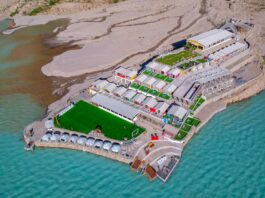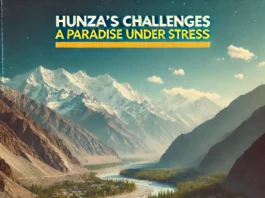Search for information about Hunza Valley
The report provides information about Hunza Valley, a mountainous region in the northern part of the Gilgit-Baltistan region of Pakistan. It shares borders with Ishkoman, Shigar, Afghanistan’s Wakhan Corridor, and the Xinjiang region of China. The valley consists of three regions: Upper Hunza (Gojal), Central Hunza, and Lower Hunza (Shinaki).
The history of the region is mentioned, including the presence of Buddhism before the arrival of Islam. The region played a significant role in the transmission of Buddhism throughout Asia. The article also mentions the former princely state of Hunza, which was dissolved in 1974.
The tourism potential of the Hunza Valley is highlighted, with its popular tourist destinations such as Rakaposhi mountain, Baltit Fort, Altit Fort, and various lakes including Attabad Lake and Borith Lake. The valley offers views of several high peaks above 7,000 meters and is known for its eco-friendly hiking treks. The valley is also believed to be the inspiration for the mythical valley of Shangri-La.
The text also mentions a 2018 rescue mission where Pakistan Army pilots rescued foreign mountaineers stuck in a snow avalanche on Ultar Sar Peak.
Overall, the provided information can be used to update or start notes for the video about Hunza Valley.
Search for popular tourist attractions in Hunza Valley
Popular Tourist Attractions in Hunza Valley
Introduction: Hunza Valley, located along the Central Asian Silk Route, is renowned for its natural beauty and captivating landscapes. This report aims to highlight the top tourist attractions in Hunza Valley, providing valuable information for a video project.
Top 10 Places to Visit in Hunza Valley:
- Rakaposhi Peak: A majestic mountain offering breathtaking views.
- Karimabad: A village known for its cherry and apricot trees, small market, Queen Victoria Monument, Channel Walk, and Ulter Nala glacier.
- Altit Fort: An ancient fort that showcases local culture and offers mesmerizing views.
- Baltit Fort: A towering fortress with a rich history and stunning panoramic views.
- Attabad Lake: A major tourist attraction with crystal turquoise water.
- Rush Lake: A serene lake located in the Nagar Valley, offering a peaceful retreat.
- Sost Border: The point where the China-Pakistan border passes through the Mintika pass.
- Gulmit: A village offering impressive views and unique cultural spots.
- Borith Lake: A serene lake surrounded by vast plains, accessible by a jeep ride from Husseini village.
- Eagle Nest Duiker: A famous viewpoint in Dukair, providing panoramic views of the entire Hunza Valley.
Additional Information:
- Best time to visit Hunza Valley is from April to October, when the weather is pleasant.
- Hunza Valley is known for its lush green beauty and cold climate.
- The valley has a solid historical background and is divided into three major regions: Upper Hunza Gojal, Central Hunza, and Lower Hunza.
- Hunza Tours offers packages to explore the top 10 places in Hunza Valley.
- Each of the top 10 places in Hunza Valley has its own unique details and significance.
Conclusion: Hunza Valley is a paradise for nature lovers and adventure seekers. With its stunning landscapes, historical forts, serene lakes, and breathtaking viewpoints, it offers a truly unforgettable experience. Whether exploring the ancient forts, trekking through the valleys, or simply enjoying the tranquility of the lakes, Hunza Valley is a must-visit destination for anyone seeking natural beauty and cultural richness.
Search for the culture and traditions of Hunza Valley
The Hunza Valley is a picturesque destination known for its natural scenery, culture, and traditions. Surrounded by high mountain peaks, it is popular among mountaineers and trekkers. The locals have a rich cultural heritage and are known for their hospitality, traditional music, and dances. Apricots are a popular fruit in the valley, and the people are known for their longevity. The best time to visit is from April to October. The valley is known for its natural beauty, cultural significance, and strategic location. It is surrounded by snow-capped peaks and is home to glacial lakes. Hunza Valley has a rich history influenced by different cultures and civilizations. The people follow diverse religious beliefs, with the majority being Ismaili Muslims. There are stunning mountains, glaciers, rivers, and lakes in the valley. Historical landmarks and forts, such as Baltit Fort and Altit Fort, offer a glimpse into the region’s history and cultural heritage. The valley also has unique traditional food and cuisine. Baltit Village is famous for its traditional houses, and Eagles Nest is a viewpoint that provides breathtaking views. The food and cuisine reflect the unique culture and geography of the region, with popular dishes like “chapshuro” and “mamtu.” The valley offers various trekking routes, such as the Karakoram Expressway (KKH) journey and the Batura Glacier trek. It is also a popular destination for rock climbing and mountaineering, with challenging peaks like Rakaposhi and Ultar Sar.
Summarize the history of Hunza Valley
The Hunza Valley is a mountainous region located in the northern part of the Gilgit-Baltistan region of Pakistan, bordering Ishkoman, Shigar, Afghanistan’s Wakhan Corridor, and the Xinjiang region of China. The valley is divided into three regions: Upper Hunza (Gojal), Central Hunza, and Lower Hunza (Shinaki).
Historically, the region was a hub for Buddhism before the advent of Islam, playing a significant role in the spread of Buddhism throughout Asia. The valley was also home to the former princely state of Hunza, which was dissolved in 1974.
The Hunza Valley is a popular tourist destination, known for its breathtaking views of high peaks above 7,000 meters, eco-friendly hiking treks, and landmarks such as Rakaposhi mountain, Baltit Fort, Altit Fort, Attabad Lake, and Borith Lake. The valley’s beauty is so renowned that it is believed to have inspired the mythical valley of Shangri-La.
The valley’s history also includes a 2018 rescue mission where Pakistan Army pilots saved foreign mountaineers trapped in a snow avalanche on Ultar Sar Peak. This event further highlights the adventurous spirit and natural beauty of the region.
Summarize the tourist attractions in Hunza Valley
Hunza Valley, a gem along the Central Asian Silk Route, is a paradise for nature lovers and adventure seekers. It is home to the majestic Rakaposhi Peak, the charming village of Karimabad with its cherry and apricot trees, and the ancient Altit and Baltit Forts that offer mesmerizing views. The valley also boasts of stunning lakes like Attabad and Rush Lake, and the Sost Border where the China-Pakistan border passes. Other attractions include the village of Gulmit, Borith Lake, and the Eagle Nest Duiker viewpoint. The best time to visit is from April to October. Each attraction has its own unique details and significance, making Hunza Valley a must-visit destination for its natural beauty and cultural richness.
Summarize the culture and traditions of Hunza Valley
The Hunza Valley, a picturesque destination, is renowned for its stunning natural scenery, rich cultural heritage, and unique traditions. The valley is surrounded by towering mountain peaks, making it a popular spot for mountaineers and trekkers. The locals are known for their hospitality and have a vibrant culture, which is reflected in their traditional music and dances. Apricots, a popular fruit in the valley, are a testament to the region’s fertile lands. The people of Hunza are also known for their longevity, which is often attributed to their healthy lifestyle and diet.
The valley’s cultural significance is deeply rooted in its history, which has been influenced by various cultures and civilizations. The majority of the population practices Ismaili Islam, adding to the diversity of religious beliefs in the region. The valley is home to historical landmarks and forts, such as Baltit Fort and Altit Fort, which offer a glimpse into the region’s past.
The Hunza Valley is also known for its unique traditional food and cuisine, which reflect the culture and geography of the region. Popular dishes include “chapshuro” and “mamtu”. The valley’s strategic location, surrounded by snow-capped peaks and glacial lakes, adds to its natural beauty.
The best time to visit the Hunza Valley is from April to October. During this time, visitors can enjoy breathtaking views from viewpoints like the Eagles Nest, explore traditional houses in Baltit Village, and embark on adventurous trekking routes like the Karakoram Expressway (KKH) journey and the Batura Glacier trek. The valley is also a popular destination for rock climbing and mountaineering, with challenging peaks like Rakaposhi and Ultar Sar.




